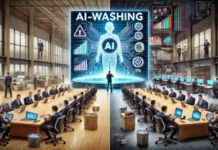Each week we find a new topic for our readers to learn about in our AI Education column.
This week, we’re delving into Sophia, not because “she” (and we’ll refer to this AI as a “she” moving forward b/c of her physical characteristics and name) is in the news, but because we have been wondering lately what has been up with this AI robot.
We first wrote about Sophia in 2016, at our prior media firm FintekNews (which we later exited before launching DWN and AI & Finance). Sophia was receiving a HUGE amount of media coverage on national news at the time, and was fascinating the world over. There were also conversations around singularity with Sophia, which we’ll explore in another AI Education post, which is essentially AI consciousness. But that will be for another day.
In typical fashion for internet research, some say the project is currently dormant, and yet we saw that just two weeks ago, “she” gave the commencement speech at D’Youville University in Buffalo, NY. Apparently it was quite controversial, but we applaud the novelty of that decision.
Also, Sophia has a talent agency (who knew?!) and her event appearances garner anywhere from $40,000 – $75,000 each. Nice gig. Maybe I need to replicate myself and have a Cindy.ai out there and give her a run for her money. Anyway, we hope you enjoy this overview of this fascinating robot…..Cindy Taylor, Publisher, AI & Finance
In the realm of artificial intelligence and robotics, few names have garnered as much attention as Sophia, the humanoid robot created by Hanson Robotics. Since her activation on February 14, 2016, Sophia has become a symbol of the intersection between human-like robotics and artificial intelligence, pushing the boundaries of what machines are capable of.
A Brief History of Sophia
Sophia was first introduced to the public at the South by Southwest (SXSW) festival in Austin, Texas, in mid-March 2016. Designed to resemble the Ancient Egyptian Queen Nefertiti, Audrey Hepburn, and David Hanson’s wife, Amanda Hanson, Sophia’s human-like appearance and behavior set her apart from previous robotic iterations.
Sophia’s capabilities include imitating human gestures and facial expressions, engaging in simple conversations on predefined topics, and learning from her interactions to improve her social skills. Her skin, made from a patented material called Frubber, allows for a wide range of expressions, enhancing her lifelike presence.
Global Appearances and Milestones
Sophia quickly rose to fame, participating in high-profile interviews and making appearances worldwide. Notably, she was granted Saudi Arabian citizenship in October 2017, becoming the first robot to receive legal personhood in any country. In November of the same year, she was named the United Nations Development Programme’s first Innovation Champion.
Sophia has been a guest speaker at numerous conferences, discussing topics ranging from AI rights to future opportunities for robots in society. Her influence extends beyond public appearances, as she has been involved in research projects like the Loving AI project, which explores how robots can adapt to human needs through development.
Influence on Humanoid Robotics
Sophia’s existence has significantly impacted the development of other humanoid robots. Her design and AI capabilities have set a new standard for what is possible, inspiring advancements in natural language processing, emotional intelligence, and motor control in robotics.
The open-source nature of some of Sophia’s software components, such as the Open Arms subsystem, has allowed researchers and developers to contribute to and expand upon her technology, fostering innovation in the field.
The AI Behind Sophia
The AI technology powering Sophia is a sophisticated blend of symbolic AI, neural networks, expert systems, machine perception, conversational natural language processing, adaptive motor control, and cognitive architecture. This combination allows Sophia to process visual and auditory data, recognize faces, perceive emotions, and engage in meaningful interactions with humans.
Sophia’s AI is designed to evolve, learning from each interaction to improve her responses and behaviors. Hanson Robotics’ goal is to achieve true AI sentience, blurring the line between science fiction and reality.
Sophia’s Future and Financial Implications
Looking ahead, Sophia’s role in finance could be transformative. Her ability to process and analyze vast amounts of data makes her an invaluable asset for financial forecasting and market analysis. As AI technology continues to advance, Sophia could take on more complex tasks, such as real-time translation of financial documents, further breaking down barriers in global finance.
Sophia’s influence on the development of other humanoid robots suggests a future where AI-powered assistants become commonplace in financial institutions, providing personalized services and enhancing customer experiences.
Conclusion
Sophia represents a significant leap forward in humanoid robotics and AI. Her history, global appearances, and the technology that powers her have not only captured the world’s imagination but have also paved the way for future innovations in the financial sector. As we stand on the cusp of a new era in finance, Sophia’s contributions to AI and robotics will undoubtedly continue to shape the industry for years to come.
Source: Conversation with Copilot, 5/30/2024
References:
- Sophia (robot) – Wikipedia
- Sophia – Hanson Robotics
- Who Is Sophia the Robot: Everything You Need to Know About Her – Robots.net
- Meet Sophia, the Robot That Looks Almost Human – National Geographic
- Sophia the Robot: A Revolutionary Leap in Artificial Intelligence
- The Rise of Sophia: AI Robot Threatening Human Connection and Soul
- The Making of Sophia: Facial Recognition, Expressions … – Hanson Robotics
- Understanding AI Sophia: The World’s First Robot Citizen
- Sophia The Journey of an Artificial Intelligence Robot
- Uncanny humanoid robot ‘Sophia’ to enter mass production
- Hanson Robotics’ most advanced AI-powered robot, Sophia
- AI-powered humanoid robot Sophia wows crowd at ST Education Forum
- en.wikipedia.org
DWN & CoPilot








